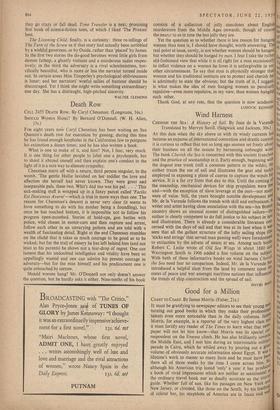Wind Harness
CHERISH THE SEA : A History of Sail. By Jean de la Varei Translated by Mervyn Savill. (Sidgwick and Jackson, 30s AT this date when the sky above us with its windy currents become an expanse of international contention and drastic cont it is curious to reflect 'that not so long ago seamen set freely at their business on all the oceans by harnessing unbought w The book Cherish the Sea is concerned with this ancient franc and the practice of seamanship in it. Early enough, beginning 1, the dugout tree trunk (still a common pattern in the wilds), author traces the use of sail and illustrates the gear and tae employed in exposing a plane of canvas to capture the winds service. It is a far cry from that day to this. Until the coming the steamship, mechanical devices for ship propulsion were and—with the exception of slave leverage at the oars—not m were of value. Still, the years brought notable development Mr. de la Varende follows the trends with skill and enthusiasm writer and artist having close association with the sea—his Bre ancestry shows an unusual muster of distinguished sailors— author is clearly competent to do full justice to his subject in 1 and illustration. There is already a considerable literature c cerned with the days of sail and that was at its best when it ' seen that all the gallant structure of the lofty sailing ships I 'sticks and strings' that served man passing well) were foredoor to extinction by the advent of steam at sea. Among such b0 Robert C. Leslie wrote of Old Sea Wings in about 1880 Warrington Smith in 1906 added a fine volume on the subji With both of these informative books on wind harness Chet the Sea need fear no comparison. Indeed, Mr. de la Varende introduced a helpful slant from the land by comment upon states of peace and war amongst maritime nations that influent the trends of ship construction and the spread of sail. has rel. out
hise ith the kle for
of eNY of nd .A on the el on' ives the ned olo no cc. isle
at he
ed DAVID 13(
0


































 Previous page
Previous page